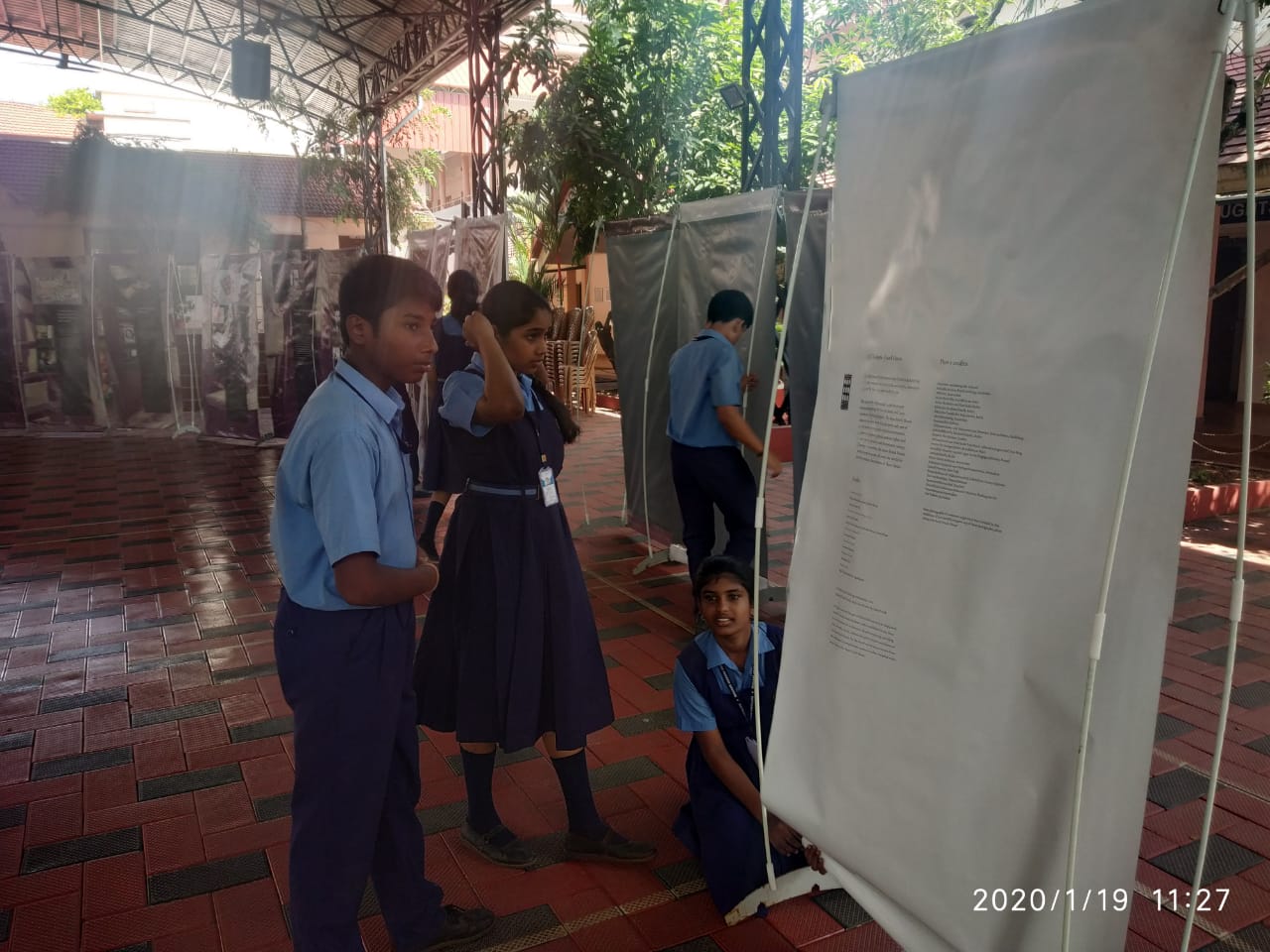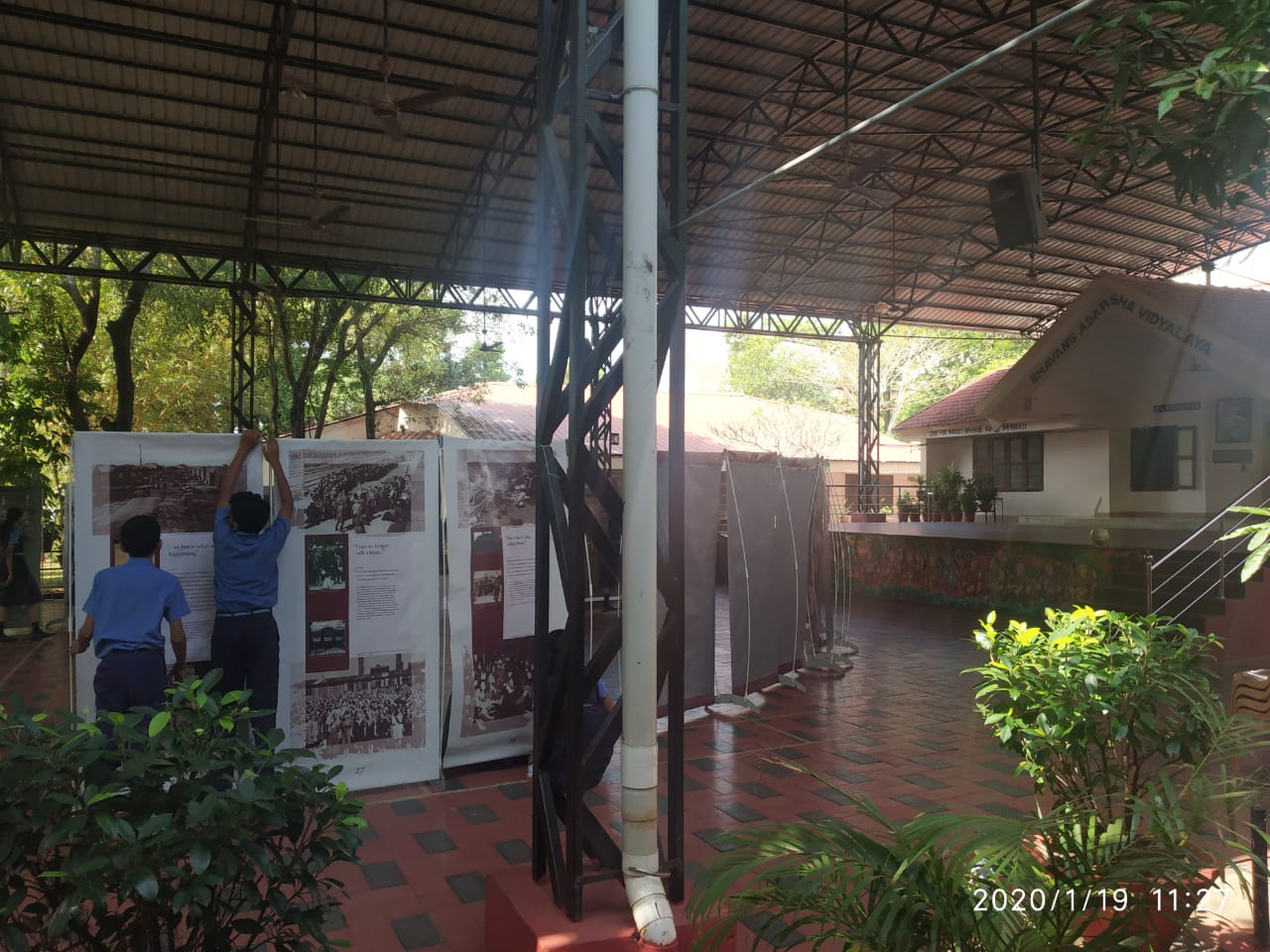After the last Anne Frank: A History for Today exhibition I conducted, in Saikul (Manipur), the prospect of one in Kochi seemed ordinary enough. 30 class 8 students from across 7 (CBSE) Bhawans schools from across Kochi. How much novelty could I find?
Day 1
At 9 AM on the morning of 19 Jan the 31 of us began the process of getting to know each other. A basketball was found and put to use as we discovered each other’s names, likes and dislikes.
ccccMost of the students knew of Anne Frank’s existence, with at least ten of them having read sections from her diary. Deciding to make the most of this, I asked these students to share what they think the diary was about, with their peers. ‘About a girl in hiding, a family persecuted in Nazi Germany, a girl who loved to write in her diary’ were some of the core points of their responses. So far so good. When the questions dug a little further—was her family alone persecuted, why, what was happening in Germany—the answers became sketchier. The second world war had only been covered in a brief section in their class 5 history textbooks to make a re-appearance in class 10. We discussed what the students’ favourite media of expression are and why, what they found difficult to express and whether they had experienced or witnessed any form of exclusion, how and what it made them feel.
ccccWith the tone set, we moved to setting up the exhibition. Installed in less than half an hour, the students proceeded to debate the best way to design the space in order to highlight the green and natural light it afforded us. Ink-plans were drawn on fists, negotiations made, and balances were struck—good and bad, as the students got caught up in what inadvertently became an exercise in democratic planning and decision making.
ccccWe returned post tea-break to a disaster. The openness of the venue that had so appealed to us also meant that the exhibition material was completely subject to the gusts of wind that seem to characterize Kochi afternoons. We spent close to an hour trying to fix the situation, both with and without the school’s staff support, with little effect. This upset my planning for the day in two ways: one, I had intended to get the students started on reading the contents of the panels—now rendered impossible since the panels were not stable and/or upright, and ii) the material was likely to soon show signs of wear because of the impact of the wind. Deciding to not spend further time on this, we lay the panels flat on the ground to minimize damage, and proceeded to lunch.
ccccSince the option of getting the students to walk through the text of the panels was no longer available, I decided to assign the post-lunch session to screening the film and discussing it. Easier said than done I realized when I saw how drowsy the students seemed post-lunch. By the time the film ended and I had asked a question or two about what they thought, the energy in the room had plummeted, with no responses forthcoming, it was unclear if any part of the film had registered with any impact on the students.
cccc Next, I did a ‘discrimination exercise’ with them. In the half-baked hope of snapping them out of this stupor, I asked everyone with the letter ‘i’ in their first names to stand to one side of the classroom. I announced that these students were to blame for the problems we had so far had over the entire workshop, and would in the future have to wear ‘i’ badges as markers of their identity. The rest of the students were instructed to not associate with any of them, which instantly invoked loud ‘why’ s and refusals. I increased the pressure points for the rest of the class: your test marks will be reduced if you associate with them, you will not be allowed to participate in extracurriculars of your choice, one week’s suspension, disallowed from writing exams and finally expulsion. As the threats intensified, the number of students who had vigorously vocalized their support for their ‘i’- peers reduced in number, along with every new threat dampening their attitude. When I asked how their parents might react to their being barred from sitting for exams, the enthusiasm visibly faded from many faces. Whatever the efficacy of this exercise, it served to wake the students up as well as provide ample scope to make connections between their reactions and the contents of the film.
ccccFor instance, one student remarked that they could all wear ‘Team I’ badges. When I asked why, he said it would cause some confusion in identifying students by the letters in their names. When I reminded him that I could access the classroom register for that data, he suggested that the register would then have to be made to go missing or be destroyed — a point I could link to the section in the film that shows the burning down of the office of records as part of anti-Nazi resistance.
ccccThis time when I asked what they took away from the film or what stayed with them, the responses were almost instant. ‘She had to hide and be quiet for nearly two years. I can’t be still for one day’, ‘She couldn’t help her friends’, to more unusual questions such as : ‘how did the family afford necessities from the market when there was inflation—did they save money, did they have black money?’, ‘Why did Otto’s colleagues help the family even though they are not Jews?’. While the questions were not all expected, they lent very well to generating a discussion that allowed for many assumptions and biases to be addressed, probed. When we were discussing the idea of ‘scapegoating’ (which led to talking about ‘others’ who are perceived to be receiving more than they deserve, more that should actually not be ‘theirs’), reservations and caste came up. One of the students told us about an instance that made her think that reservations were outdated and unfair. This allowed me to probe further with questions on systemic marginalizing, access to resources, cultural and other capital.
Day 2
The next morning, with the panels mostly secured to support and standing upright, I allotted the students 90 minutes to familiarize themselves with the text of the panels, ask questions. The range of questions was most refreshing, some of which are listed below.
‘Do you think it would be wrong to design the exhibition like a swastika?’ one student asked. I asked why he thought it might be. He explained that it might be offensive owing to the symbol’s position in Germany’s Nazi history, so I asked him to give me a convincing argument why designing it that way would add to the exhibition, if he wanted to design it that way.
‘If Hitler had invaded India, would Germany have been racist to India?’ This imaginative question stumped me for a second before we got talking about a range of topics, from a historical link between fascist Germany and colonial India wrt Subhash Chandra Bose, to the idea of ‘Aryan’ in both ancient Indian and modern German history to what forms of racism the student thought are practised in India.
‘What does sterilization mean? Why did they take away bicycles?’ That a government could be part of such personal equations as marriages, the choice of reproducing and even access to movement in the form of bicycles was not something the students could accept easily.
‘Hitler’s grandmother was a Jew, she was bad to him, do you think that’s why…?’— this was one of many Hitler trivia questions I was asked by the students over two days, much disappointment expressed when I couldn’t answer what Hitler had against cats. I asked the students why they thought the exhibition was focused around Anne’s life, why it was named after her and why Hitler was topmost in their minds despite the exhibition being about this young girl. These questions led to a slow but (what I thought was a) valuable discussion on what and how human beings tend to see and remember. We also spent some time considering what response of mine to their trivia questions would make them see Hitler’s regime and its holocaust as a ‘rational’ exercise. This lent itself to a discussion on the role of people in the implementation and sustaining of such a large scale project as the holocaust: who guarded the centres, who supplied the gas to the chambers, the building material, etc.
ccccNext, it was time for mock guiding. Each student picked a panel of their choice and took me around the exhibition while I asked questions. I suggested they focus on any one image in every panel whose story they wanted to tell, instead of feeling pressured to repeat the contents of the panels. Guiding strategies were re-thought, attempted.
ccccWe were just concluding when Priya (Anne Frank House, Amsterdam), joined us and stirred the students out of their pensiveness with a game, ‘Walking the Line’. The students stood in two parallel rows, moving their positions according to their answers (yes/no) to the questions Priya asked. When Priya asked the students how they connected what they saw and learned about in the exhibition with ‘today’, very few clears answers were forthcoming, little beyond vague mutterings about human rights and violence. This gave me much to think about. Why was it that the discussions woven around the impact of the exhibition material, that saw such active participation from the students, did not translate into articulate responses when they were asked if they could make links between the narratives in the exhibition and the worlds they inhabit. Was the duration of the training not long enough, did the students have too little exposure to socio-political concerns to draw such parallels, was it too little time to process the conversations into articulable responses? I shared my concerns with Megha who then proceeded to engage the students in an informal discussion on contemporary socio-political concerns.
ccccThe school organized a grand opening ceremony for the exhibition, after which the peer guides had their first flood of visitors—school board members, principals, teachers from across the country as well as academics who were there to speak at a History for Peace conference. Since I had occasion to be in the school for two further days owing to this conference being held on the premises, I visited the exhibition on both days to have informal discussions with the students on the kinds of questions their visitors were asking, which ones stumped them, and around the connections they were making between the exhibition and ‘today’ as the exhibition grew on them.
ccccWhile it was not possible to fully gauge if these discussions did anything to shape their peer-guiding, the students’ sense of self-assurance as well as their grasp of the information and history they’d been exposed to had certainly increased as they held forth on the stories they wanted to tell their visitors with far more confidence than they had begun with. As I was leaving I heard a peer-guide talking about the idea of Aryan purity, asking one of her visitors—’Remember how they discriminated against the mudbloods in Harry Potter?’
-Ranita






